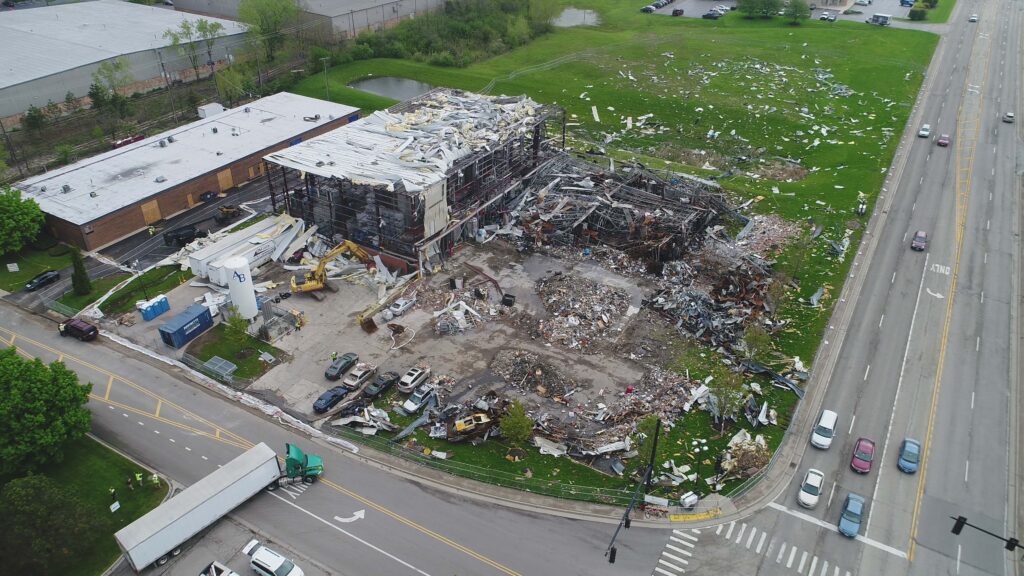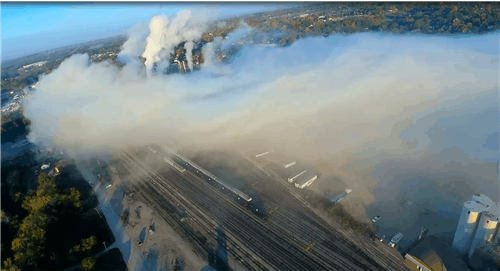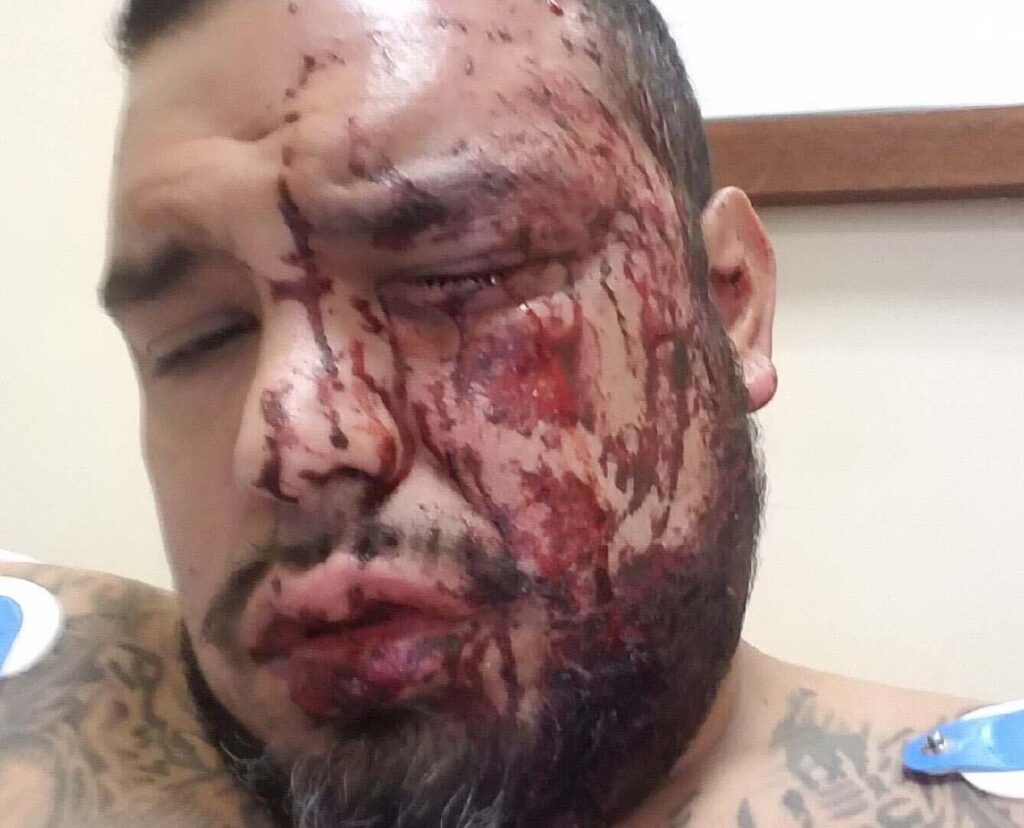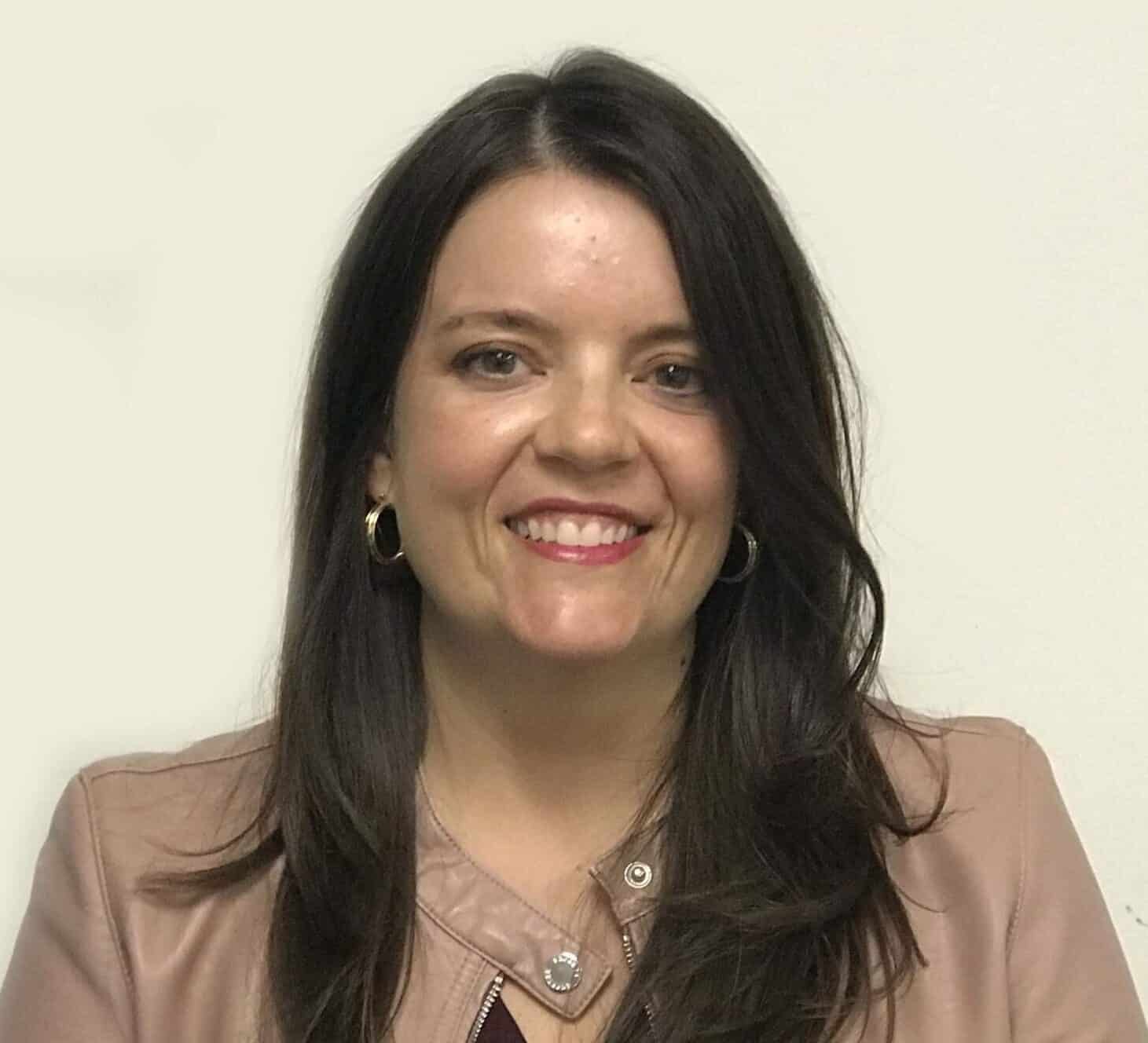This story was published in partnership with Vox. The Center for Public Integrity is a nonprofit newsroom that investigates betrayals of public trust. Sign up to receive our stories.
Introduction
It was late in the second shift when workers at a silicone factory in Illinois noticed something had gone wrong. A tank of silicon hydride, used to make water repellent, started foaming and hissing. An operator mixing the chemicals in the tank yelled in frustration. Two of his coworkers came running. A pale yellow haze filled the air. It was hot. None of this was normal.
A supervisor quickly ordered one worker to turn on the exhaust fans and another to open the building’s garage doors, but neither got the chance. Within seconds, the 30,000-square-foot building exploded, rattling homes and businesses within 20 miles of the Waukegan, Illinois, factory. Rescue crews had to sift through the rubble for four days to find each of the bodies.
Four workers died the night of May 3, 2019, at AB Specialty Silicones, including the chemical operator and his boss. Yet the public may never find out what caused the explosion, and other chemical companies may never learn how to prevent a similar blast. That’s because the small, independent federal agency that investigates chemical disasters is on life support, and the Trump administration wants it to disappear altogether.

That agency, the Chemical Safety and Hazard Investigation Board, investigates accidents and makes recommendations — though it doesn’t regulate the industry. Since 1998, it has looked into some of the nation’s biggest industrial disasters, including the 2010 Deepwater Horizon blowout, which killed 11 workers and dumped an estimated 4 million barrels of oil into the Gulf of Mexico, and the 2005 explosion at the BP refinery in Texas City, Texas, that killed 15 workers and injured 180. The board’s work has led to changes in industry practices from Texas to Kansas and laws in states from Mississippi to Connecticut.
But it’s likely that, when the investigation into the AB Specialty Silicones explosion wraps up, the board will not be able to meet the quorum needed to vet and approve investigators’ findings and recommendations. Since May 2, it has been operating with only one voting member out of a possible five — one vote short of a quorum. It’s been effectively disabled.
The White House hasn’t announced plans to fill the board’s four vacant seats. In fact, President Donald Trump has been trying to do the opposite, pushing to eliminate the board in each of his annual budget proposals — though he hasn’t persuaded Congress to defund it.
Without a quorum, the board will not be able to release the final reports from any of its 13 pending investigations.
The situation creates “a very difficult challenge,” Rick Engler, whose term on the board ended in February, told the Center for Public Integrity. “We continue to have chemical disasters, and the [board’s] recommendations save lives.”
The inspector general at the U.S. Environmental Protection Agency, which oversees the board, recently called the situation a matter of “elevated urgency.”
“Having only one member impairs the function of the [board],” the inspector general’s July report stated.
The White House did not respond to a request for comment.
The board’s undoing reflects a broader dysfunction at federal agencies under Trump’s watch. The president has repeatedly failed to appoint leaders at agencies he considers unnecessary, making it nearly impossible for some to operate.
That’s happened, for example, at the Federal Election Commission. For nine months, the FEC didn’t have enough commissioners to take key enforcement actions, such as reviewing possible campaign finance violations. The U.S. Merit Systems Protection Board, meanwhile, hasn’t had any board member since February 2019, and is unable to review workplace complaints from federal employees.
Unlike the FEC and the Merit Systems Protection Board, however, the Chemical Safety Board’s work is a matter of life and death. Millions of people in America — mostly workers, but also members of the public — are at risk from fires, explosions or chemical releases, and many of them probably don’t realize it.
Things can go very wrong, very quickly
The United States is among the world’s top chemical producers. More than 12,000 facilities handle toxic or flammable chemicals, used to make everything from pharmaceuticals to fertilizers, and are often located near businesses and residential areas. The Congressional Research Service found that 90 of these facilities each put a million or more people at risk from accidents in worst-case scenarios. As of 2014, about 4.6 million children attended school within a mile of a chemical plant, according to the Center for Effective Government.

The Chemical Safety Board sends investigators to places like Atchison, Kansas, where 800 middle and high school students were evacuated from class in 2016 after a greenish-yellow cloud of chlorine escaped from a factory that distills alcohol and corn oil. Its final report pinpointed the cause of the accident (a tanker truck driver delivering sulfuric acid mistakenly mixed it with sodium hypochlorite — bleach) and made recommendations to the factory’s owner (such as installing alarms to keep workers from opening the wrong valve, as happened in this case). The owner ultimately followed all the recommendations and made changes to factory practices.
The board’s work has also led to broader reforms. Its 2010 investigation into a deadly explosion at a Connecticut construction site, for example, prompted the state to ban companies from using pressurized natural gas to clean pipes, a process known as gas blowing. Its recommendations also strengthened New York City’s fire code and raised safety standards at oil and gas sites in one Mississippi county.
“The CSB’s findings are very influential,” Chris Jahn, president of the American Chemistry Council, a trade group that represents the chemical industry, said at a Senate hearing in January. He urged the administration and the Senate to quickly fill the board’s four vacant seats.
The council has criticized some of the board’s recommendations, particularly those that call for more industry regulation. Jahn’s testimony on the importance of the board reflects the depth of support for keeping it alive.
Labor unions also want to see the board survive. “This is a critical agency for us,” said Mike Wright, director of safety, health and environment for United Steelworkers, which represents more than 570,000 workers in some of the nation’s most hazardous industries. “Their reports have helped us improve safety at many plants.”
But the unfolding crisis has slowed the board’s work to a crawl. Until a new voting member is appointed and confirmed, pending investigations are stuck in limbo, bringing into question whether companies will learn how to prevent fatal explosions, similar to the ones that destroyed a Wisconsin corn mill and a chemical factory in Crosby, Texas.
More than a year after the AB Specialty Silicones explosion, the board’s investigators are still sifting through evidence to pinpoint the cause.
A separate investigation by the US Occupational Safety and Health Administration found several safety violations at the factory. According to OSHA, the electrical equipment was improperly installed, and workers were moving flammable liquids on forklifts that ran on propane, which could ignite the chemicals.
OSHA cited the company for 12 “willful” safety violations and proposed $1.6 million in fines. The company is contesting the citations.
In a statement to Public Integrity, a company spokesperson said the scope of the OSHA report went “beyond the elements that may have contributed to the tragic explosion” and noted that a third-party investigator AB Specialty Silicones hired traced the explosion to a “human error that resulted in the mistaken addition of an erroneous ingredient.”
“We look forward to CSB’s more comprehensive work on the cause of the tragedy that has made such an impact on our AB family and our Waukegan community,” the statement said.
But a spokesperson for the board said the investigation will take some time — unlikely to be completed until fiscal year 2021.
Lives and homes destroyed
The board is also still investigating a factory explosion in Houston that killed two people and damaged hundreds of homes. The January 24 blast at Watson Grinding and Manufacturing lit up the night sky and flung debris into nearby neighborhoods, injuring dozens of people. One of them was Sean Rangel, who had worked at the factory for seven years. The 38-year-old welder was parking his pickup truck outside the factory when the blast ignited.
As he backed into a parking spot, Rangel saw one of his supervisors, Frank Flores, walking toward the building’s front door, then saw a flash of light in his rearview mirror. The explosion flipped over Rangel’s Dodge Ram and shattered its windows.
“I thought I got hit by a truck, but my ears were ringing,” Rangel said by phone. He crawled out of the truck and surveyed the scene. “The building wasn’t there anymore; all I could see was metal. At that moment, I knew that Frankie didn’t make it.”

Flores — “Frankie” — was one of two workers killed that morning. If Rangel had arrived at work 30 seconds earlier, he might have died, too. The force of the explosion popped his left eardrum and cut his left eye; he was otherwise unhurt. The trauma, however, has stayed with him.
“I can’t sleep,” Rangel said. “I’m scared to go places. I don’t know the next time something might happen.”
Rangel and his coworkers lost their jobs when Watson filed for bankruptcy a few weeks after the explosion. Now he’s suing the company for negligence. Watson also faces a class-action lawsuit from more than 200 homeowners whose properties were damaged. A lawyer representing the company did not respond to a request for comment. In court filings, company representatives denied the allegations from Rangel and homeowners.

shattered its windows. (Courtesy of Sean Rangel)
Rangel suspects a gas leak triggered the explosion, but no one knows for sure. The Chemical Safety Board sent investigators to the scene on the day of the explosion, but they have yet to complete their investigation.
The board’s investigative process is not much different from that of the National Transportation Safety Board, which investigates high-profile transportation accidents, such as the helicopter crash that killed former NBA star Kobe Bryant, his daughter and seven others near Los Angeles in January.
But the NTSB dwarfs its younger cousin. It has a staff of about 400 and an annual budget of $110 million. The Chemical Safety Board has a staff of 40 — including nine investigators — and a $12 million budget, forcing it to concentrate on the worst industrial disasters, such as the Deepwater Horizon explosion.
The need for more investigators is clear: The board’s database shows an annual average of 183 chemical accidents that killed, injured or sickened someone over the past decade.
However, each year, investigators are only able to look into about five major accidents. Their findings and recommendations are then vetted by the board’s voting members, and, if approved, a final report is released publicly.
While the board’s findings have led to stricter regulations and practices, it’s also not unusual for industry groups and companies to reject the board’s findings and recommendations. The oil and gas industry — which, according to the Center for Responsive Politics, has contributed about $2 million to Trump’s reelection campaign — has pushed back against a recommendation for new federal rules that would require oil rigs and refineries to meet stricter safety standards. The industry’s main trade group, the American Petroleum Institute, opposed the rules, saying they would cost companies too much money without improving safety or lessening environmental risks.
The chemical and oil industries also fought an EPA rule, issued at the end of the Obama administration, that among other things would have required companies to conduct independent audits of major chemical accidents — something the board recommended. The Trump EPA eliminated this provision, along with others, last year.
A prominent opponent
No stakeholder has worked harder to weaken the board than Trump’s White House, which has tried to shut the board down four times.
The administration first announced its intention to defund the board in Trump’s budget proposal in 2017, arguing that the board’s work overlapped with other agencies and has generated “unhelpful friction” between them. The White House said the board’s push for regulatory changes had “frustrated” businesses and even some regulators, though it did not specify what the friction was about.
This did not sit well with the steelworkers union and other board supporters.
“It was infuriating,” Wright said. “A lot of the things that are getting people killed are not addressed” by regulatory agencies such as OSHA.
The board had just emerged from a rough period when Trump announced his intention to eliminate it. Complaints about board mismanagement triggered two House investigations in 2014 and criticism from the EPA’s inspector general. The board’s chair at the time, Rafael Moure-Eraso, resigned under pressure in 2015 amid complaints of mismanagement. In the years that followed, Vanessa Allen Sutherland, the new chair, revamped the board, turning around investigations more quickly and improving morale. But she left in 2018 to take a job at a railroad company.
In the end, Trump’s plan to defund the board has proven unsuccessful: Congress has voted to fund it every year.
“This is completely unacceptable. It’s in everyone’s interest to keep the board functioning.”
Sen. John Barrasso, R-Wyoming
But the board now faces an existential crisis. The last three members left because their five-year terms had expired or were about to end. In their place, the White House has nominated only one member: Katherine Lemos, who previously worked at the NTSB and the Federal Aviation Administration.
Members of the Senate’s Environment and Public Works Committee voted unanimously to confirm Lemos in September, but Senate leaders didn’t move forward with a full vote in the chamber for months.
“This is completely unacceptable,” committee chair Sen. John Barrasso, R-Wyoming, said during a January hearing. “It’s in everyone’s interest to keep the board functioning.”
Lemos’s confirmation was finally pushed through in March, right as Kristen Kulinowski — the only member left at the board at the time — was preparing to take another job as her term ended.
Lemos joined the board at the end of April. For the first time in months, the board had two members — albeit for one week.
The last woman standing
On April 29, the board held its quarterly meeting in a small conference room two blocks from the White House. Lemos, Kulinowski and the board’s attorney sat behind a long table.
It was Kulinowski’s last meeting on the board and Lemos’s first.
We can’t do this work without your support.
Kulinowski updated Lemos, who would succeed her as the board’s chair on the 13 pending investigations she was leaving behind. Kulinowski said investigators are still reviewing evidence from the blast at AB Specialty Silicones and the factory explosion in Houston. She said two investigations were put on hold because the board doesn’t have enough staff.
No one mentioned that, once Kulinowski departs, Lemos wouldn’t be able to vote to close the investigations.
Kulinowski, who now leads the federally funded IDA Science and Technology Policy Institute, told Public Integrity the board wasn’t designed to function with so many empty seats. Yet she rejected the notion that its death is imminent.
“The CSB has such an important mission, and we survived so many threats to our existence while I was there and even before I arrived,” she said.
At the April meeting, Kevin Druley, an editor at the National Safety Council, an Illinois-based nonprofit that promotes public safety, asked how the board would operate with just one member.
“That’s an excellent question,” Lemos responded, adding that she didn’t have any information to provide. “But we are working through those details.”
Those details were still unresolved when Kulinowski left the board two days later.
This series was made possible through a partnership with Vox.
Read more in Money and Democracy
System Failure
The Trump administration’s war on birth control
The Affordable Care Act made birth control more accessible than ever. Then came Trump.
System Failure
Fewer inspectors, more deaths: The Trump administration rolls back workplace safety inspections
Amid the COVID-19 pandemic, the U.S. Occupational Safety and Health Administration has been cutting back even more.






Join the conversation
Show Comments